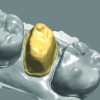You must be signed in to read the rest of this article.
Registration on CDEWorld is free. Sign up today!
Forgot your password? Click Here!
There are two keys to creating precisely fitting crowns: minimizing the number of steps in the overall creation process and minimizing the potential for human error. Extraoral scanners provide digital impressions that do both while also generating significant time and cost savings.
Easy To Use and Implement
From the perspectives of both the laboratory and the dental practice, there are key benefits to using extraoral scanners. For one thing, there is no need for any change to the clinical workflow for taking impressions. It also eliminates the need for dental offices to deal with the hassle, time, and cost involved in packaging and mailing the impression to the laboratory. An assistant simply places the trimmed impression inside the scanner and uses a touchscreen display to scan and create a detailed digital 3D file. The same display is also used to create an order and electronically transmit the files to the laboratory using the scanner's built-in server (Figure 1).
Once the laboratory receives the files minutes later, technicians could theoretically begin building the digital model immediately. Figure 2 and Figure 3 illustrate two of the stages in the model creation process.
Incorporating the extraoral scanner into a dental practice poses minimal if any challenges. It might require a small software update or the resolution of a minor portal issue or two between the practice and the laboratory, but the scanner manufacturer's support team can assist with that. The scanner takes up very little space, is very user-friendly, and requires virtually no training. While it requires a scannable impression material impregnated with titanium dioxide, the material is as easy to work with as conventional impression materials.
Patient Satisfaction
Patients appreciate three major advantages afforded by an extraoral scanner. First, the time from taking the impression to seating the crown is reduced from 10 to 14 days to 5 to 7 days. Second, the fit is very precise and requires little or no adjustment. When two crowns—one made using a conventional process and one using the extraoral scanner (Figure 4)—were made for the same tooth and temporarily seated with the patient, the crown produced utilizing the extraoral scanner clearly exhibited a more precise fit and required very little adjustment. It was then cemented and permanently seated. Third, should the crown ever need to be replaced for some reason, patients very much appreciate the ability to have the crown quickly reproduced without requiring another impression.
The ultimate cost to the patient should be no higher than with conventionally produced crowns. In fact, the laboratory might actually charge less for a crown made utilizing an extraoral scanner, providing the option for the client to charge the patient less than would be charged using conventional processes.
Extraoral scanners represent a special opportunity for a dental laboratory to attract new customers and to do more business with its existing clients. When dental practices understand that crowns made utilizing the extraoral scanner have a remake rate that could be as low as one-fifth the rate of conventionally produced crowns, they will surely want to know more about this impressive new technology.
Exceptional Precision
One reason for the superior precision delivered using the extraoral scanner is the fact that impressions have a lifecycle that begins the instant they are taken. They subtly morph in size and shape over time, so if it's not possible to create the model until several days after the impression was created, imprecision is inevitable. In addition, the conventional process introduces a variety of opportunities for imprecision due to the frequent human contact with the impression, including removing it from the shipping package, pouring the mold, sawing and sectioning the model, and more. In contrast, by scanning immediately after creating the impression, the information is permanently captured before any changes can occur.
A Profitable Business Model
Because of all the advantages delivered by this technology, a forward-thinking laboratory would do well to consider “donating” an extraoral scanner to a high-volume customer if the practice agrees to do a minimum percentage—or perhaps all—of its crown business with the laboratory. The increased revenue should enable the laboratory to offset the cost of the scanner in a matter of months, after which the profit stream to the laboratory should be significant. When this revenue is added to the time and money saved by no longer having to pour gypsum and stone molds, the economic appeal of extraoral scanners to the laboratory is significant indeed. The picture gets even more attractive when you consider the new business you could get once your laboratory is known as the go-to for extraoral scanner expertise.
About the Authors
Jay Collins
Owner
Cornerstone Dental Labs
Huntingdon Valley, PA
Daniel DiCostanzo, DDS
Private Practice
Hawthorne, NY
Disclosure:This article was provided by Kulzer.





